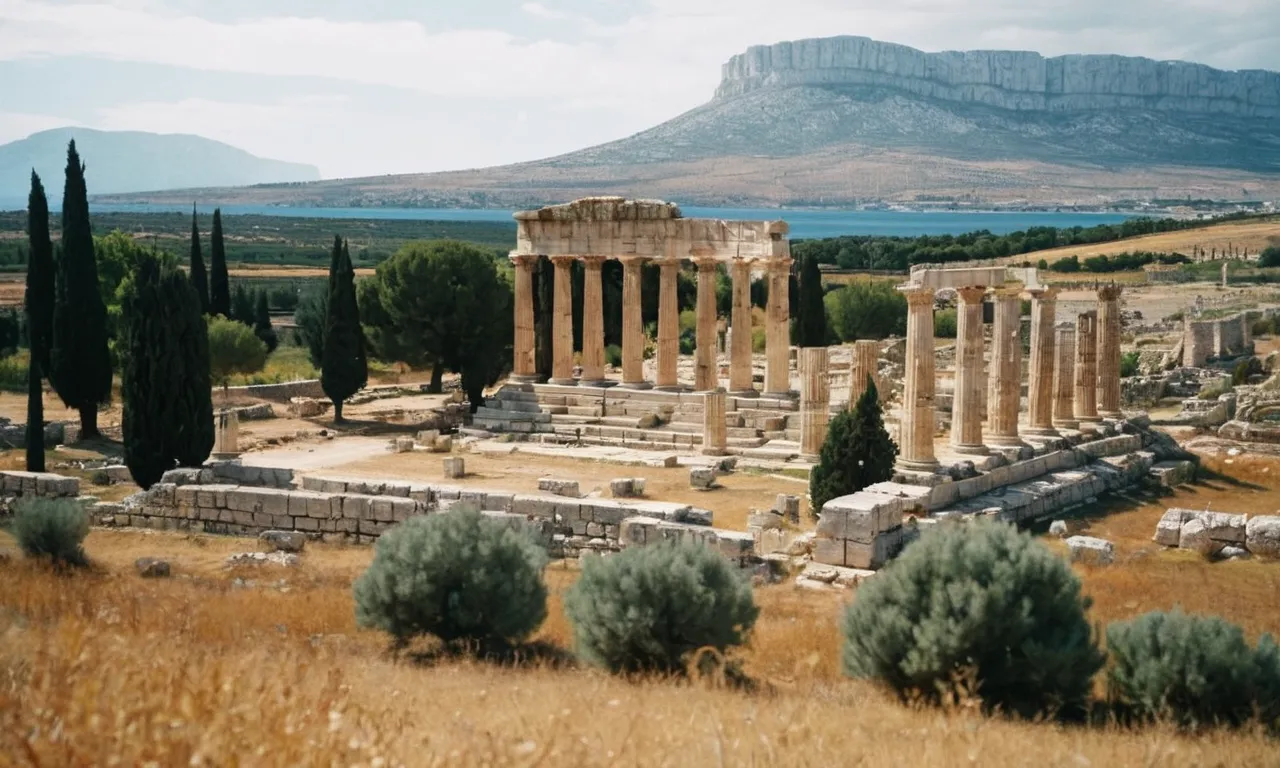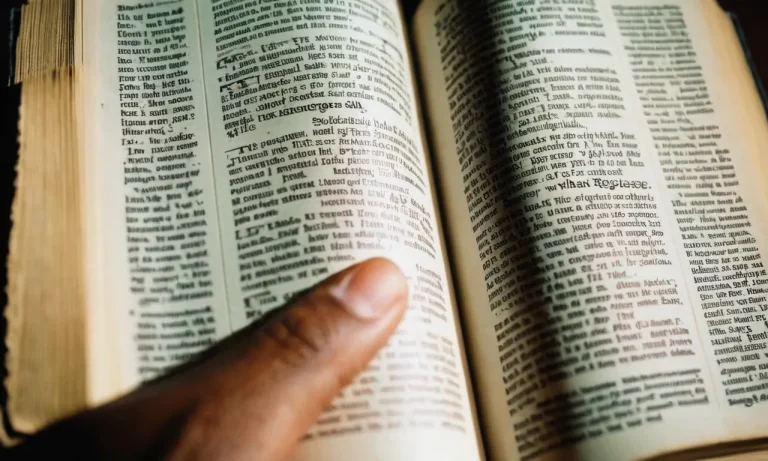What Was Corinth Like In Bible Times?
Corinth was one of the most important and influential cities in ancient Greece during Bible times. Strategically located on the narrow isthmus connecting mainland Greece to the Peloponnese, Corinth was a bustling center of trade and commerce unrivaled in its wealth and cosmopolitan culture.
If you’re short on time, here’s a quick answer to your question: Corinth was a large, diverse, and wealthy trade hub known for its cosmopolitan yet morally corrupt culture.
In this comprehensive article, we will explore what Corinth was like during Bible times, including its geography, culture, society, economy, and relationships with other major cities of that era.
Geographic Location and Layout of Ancient Corinth
Strategic Position on Isthmus
Ancient Corinth was strategically situated on the narrow Isthmus of Corinth, the land bridge connecting the Peloponnese peninsula to mainland Greece. This key position allowed Corinth to control traffic and trade between northern and southern Greece.
Good brought inland were often diverted through Corinth rather than taking the long route around the peninsula.
Corinth had ports on both the Saronic Gulf to the east and the Gulf of Corinth to the west. These harbors enabled maritime trade with Athens, Italy, Egypt, Asia Minor, and beyond. Corinth essentially profited from being the gateway between the eastern and western Mediterranean.
Layout and Districts
The walled city of Corinth had an upper Acrocorinth fortress on a tall, flat-topped hill nearly 2,000 feet high. At the base of this citadel stood lower Corinth, crisscrossed by colonnaded streets and adorned with temples, fountains, and other monuments.
Corinth contained distinct quarters for religious, commercial, administrative, and residential functions. For example, artisans and merchants had their own sections, while villas dotted the outskirts. Major structures included temples, shops, a marketplace or agora, council halls, baths, and theater.
Major Structures and Buildings
- The Temple of Apollo, constructed in 550 BC, once housed over 1,000 life-size terracotta statues and had 38 columns, 6 on the facades and 32 along the sides.
- The Fountain of Peirene provided a source of refreshing spring water through a tunnel to an underground cistern.
- The Lechaion Road connected Corinth’s ports to the main city. It was paved, lined with statues and buildings, and capable of handling two-way wagon traffic.
According to the Biblical scholar Jerome Murphy-O’Connor, no city in ancient Greece, other than Athens, could compete with Corinth in terms of magnificent buildings, spacious avenues, and impressive works of art.
The apostle Paul must have marveled at such splendor when he visited Corinth around AD 51.
For further details on the history, culture, and architecture of Corinth, see the informative articles on BiblePlaces.com and BiblicalArchaeology.org.
People and Culture of Corinth
Population and Demographics
In ancient times, Corinth was one of the largest and most important cities in Greece. Located on the isthmus connecting mainland Greece to the Peloponnese, it was a major center of trade and commerce. At its peak in the 5th and 4th centuries BC, Corinth had an estimated population of over 90,000 people, making it one of the largest cities in the ancient Mediterranean world.
Corinth had a very diverse population, drawn from its location at the crossroads of major trade routes. In addition to native Greeks, there were also Phoenicians, Egyptians, Persians, Jews, Italians, and many others that called Corinth home. The city was cosmopolitan and multicultural for its time.
Religion and Spirituality in Corinth
Ancient Corinth was a religiously diverse city. As a major Greek polis, it was home to important temples dedicated to Greek gods like Apollo, Poseidon, and Aphrodite. The Temple of Apollo and its Oracle were among the most important religious sites in Greece.
However, Corinth also had a sizable Jewish community with synagogues, as evidenced in the Book of Acts. By the time of Paul, there was also an early Christian community established in Corinth that Paul himself helped found.
In addition to traditional Greek religion and the newer faiths of Judaism and Christianity, Corinth was also known to have mystery cults from Egypt and other locations devoted to gods like Isis and Serapis. Spirituality in ancient Corinth was quite cosmopolitan and diverse.
Arts, Philosophy, and Education
Ancient Corinth was famous for its bronze work, pottery, and other crafts. Located near mines on the outskirts of the city, Corinthian artisans became masters of bronze work and developed innovative new techniques. Corinthian pottery was also prized around the ancient world.
In philosophy, Corinth was the home of founders of skepticism like Arcesilaus and Carneades. The city had schools that taught philosophy and rhetoric to educate the children of wealthy Corinthians. Theater and poetry recitals were also important in Corinthian culture.
For average Corinthians, education often came via apprenticeships in family trades and businesses. But the children of the elite were well-educated in Greek philosophy, arts, and rhetoric.
Entertainment and Recreation
As a large city, Corinth offered residents many options for entertainment in their free time. The theater was important, with tragedies, comedies, and more performed in the large theater near the agora.
Corinth also had a stadium for sporting events like footraces, javelin throwing, wrestling, and boxing.
Being a port city, sailing was a popular pastime for many Corinthians. The diolkos, a paved overland route, allowed ships to shortcut across the isthmus instead of sailing around the peninsula. This unique geographical feature encouraged sailing culture.
Corinth also had lively markets and taverns that bustled with people day and night.
Economy and Commerce in Corinth
Corinth as a Trading Hub
Corinth was strategically located on the narrow isthmus connecting mainland Greece to the Peloponnese. This geographic position allowed Corinth to control and benefit from land and sea trade routes between northern and southern Greece.
Corinth had two major seaports – Lechaeum on the Gulf of Corinth and Cenchreae on the Saronic Gulf – which enabled it to engage in maritime trade across the Mediterranean. As a trading hub, Corinth grew wealthy from importing and exporting goods and charging tolls and customs fees on cargoes traveling overland between its ports.
Major exports included ceramics, bronze works, and agricultural products such as wine and olive oil. Corinth also became a marketplace for goods arriving from all over the empire, attracting merchants from far and wide.
Major Exports and Industries
In addition to its strategic location, Corinth possessed natural resources that allowed it to develop key industries. The city had access to clay deposits ideal for pottery, as well as mines producing bronze, iron, lead, and marble.
Corinthian bronzesmiths were renowned throughout the ancient world for their high-quality bronze statues and decorations. Corinthian pottery was also in high demand, recognized for its distinctive geometric designs and delicate pottery shaped into miniature animals and human figures.
Agriculture flourished in the fertile plains around Corinth, producing olive oil, wines, and other foodstuffs for export. Manufacturing, trading, bronze-working, and pottery became pillars of Corinth’s prosperity in the classical period.
Banking and Finance in Corinth
As a busy trading hub, Corinth needed effective financial services and coinage to facilitate commerce. Ancient sources mention a number of large banking houses in Corinth with correspondents across the empire.
Money-changers set up tables near the city’s ports, while lenders could provide loans to merchants and travelers. By the 5th century BC, Corinth was minting its own high-quality silver coins known as staters.
These coins became common currency in Greece and helped fund Corinth’s public building projects and military activities. The city also benefited from an early form of insurance, with traders paying fees to spread the risks of voyages across sea and land routes.
Corinth’s banks and mints fuelled economic growth and enabled the city to become a financial powerhouse.
Impact on Other Cities and Kingdoms
Corinth’s economic influence extended far beyond its walls. Its colonies, especially Syracuse in Sicily, provided new markets for trade. Clients like Epidamnus relied on Corinthian military protection to ensure their own prosperity.
Access to Corinthian ceramics, bronzes, and other fine goods became a mark of status for Mediterranean elites. Even Athens, Corinth’s main rival, depended on imported Corinthian grain to feed its citizens.
When Corinth led the Peloponnesian League against Athens in the Peloponnesian War, the fate of the entire Greek world hung in the balance. No city, not even mighty Athens, could ignore the economic power of Corinth.
Its strategic location, natural resources, industries, and innovation made ancient Corinth a focal point of production and exchange whose legacy still impacts economies today.
Social Life and Notoriety of Ancient Corinth
Luxury, Hedonism, and Immorality
Ancient Corinth was known across the ancient world for its wealth, luxury, and moral laxity. As an important trade hub connecting major sea and land routes, the city benefitted enormously from international commerce.
Vast sums of money flowed through Corinth, enabling sensual pleasures and vices of all kinds.
The Corinthians were notorious for their hedonism and immorality. Brothels, drunkenness, gluttony, and sexually explicit artwork could all be found in Corinth. In fact, the Greek verb “to act like a Corinthian” (korinthiazesthai) was synonymous with practicing fornication.
Corinth’s notorious lifestyle is referenced multiple times in the Bible. The Apostle Paul urges the Corinthian church to reject their former sensuality, greed, and idolatry (1 Corinthians 6:9-11). He reminds them that they were “washed” and “sanctified” despite Corinth’s reputation for impurity and corruption.
The ‘Corinthian Woman’
Influenced by Corinth’s affluence and ostentatious culture, wealthy Corinthian women became symbols of excess. They had a reputation for showing off expensive jewelry and clothing, wearing elaborate hairdos, and attentively applying makeup.
Some historical accounts suggest Corinthian women had greater social freedom and independence compared to other Greek cities. Though wives were still subordinate to husbands, they enjoyed more opportunities in terms of property ownership, commerce, and litigation.
Sadly, this autonomy did not prevent the exploitation of women in Corinth’s sex trade. Enslaved female prostitutes vastly outnumbered male prostitutes. Thus, “Corinthian woman” could refer to either a prominent socialite or an enslaved sex worker.
Foreign Cults and Ecstatic Worship
As an international hub, Corinth accommodated the religious practices of its diverse populace. Dozens of temple ruins have been excavated, including those devoted to Greek, Roman, and Ancient Near Eastern deities.
Of particular prominence were the ecstatic mystery cults imported from throughout the Mediterranean world. Devotees sought frenzied experiences of divine possession through dance, music, drugs, and sexual rituals. The extreme physicality of their worship contributed to Corinth’s notoriety.
By New Testament times, the city even featured a temple of Aphrodite employing over a thousand sacred female prostitutes. Clearly, the arrival of Christianity in such a city represented a radical countercultural force battling against the predominant currents of Corinthian culture.
Corinth in the Bible and Early Christianity
Corinth in the New Testament
The ancient city of Corinth is mentioned frequently in the New Testament, giving us insight into what life was like there in biblical times. The apostle Paul visited Corinth during his second missionary journey in around 50-51 AD and spent 18 months there (Acts 18:1-18).
He later wrote two letters to the church in Corinth, known today as 1 and 2 Corinthians, in which he addressed issues the church was facing.
In Paul’s day, Corinth was the capital of the Roman province of Achaia and a major urban center with a multi-ethnic population. It had a reputation as a city full of immorality, idolatry, and pagan practices.
The temple of Aphrodite, the Greek goddess of love, employed a thousand temple prostitutes which contributed to the city’s notoriety for sexual immorality (1 Cor 6:12-20). Paul urged the Corinthian Christians to reject the immorality of their surrounding culture and live in purity.
Economically, Corinth was a prosperous commercial city with sea and land trade routes. The city’s wealth, however, also contributed to the social problems Paul mentions like lawsuits among believers, economic divisions, and food sacrificed to idols being sold in the marketplace (1 Cor 6:1-11; 11:17-34).
As a diverse urban center and Roman colony, Corinth exposed Paul to a cross-section of the Empire’s population and prepared him for future ministry in Ephesus and Rome.
Paul’s Letters to the Corinthians
Paul’s two New Testament letters to the Corinthians provide insightful glimpses into the challenges facing an early urban church. 1 Corinthians addresses divisive factions, immorality, lawsuits, abuse of Christian liberty, worship and spiritual gifts, the resurrection, and giving.
2 Corinthians deals with Paul’s complex relationship with the church, false apostles, and the character of Paul’s apostolic ministry.
These letters reveal Paul’s heart and burden for the Corinthian church. He reproves them strongly at times but also affirms his love for them as their spiritual father (1 Cor 4:14-16). Paul deals with specific issues but also provides timeless instruction about living as a community of believers in a pagan world.
His teachings on the Lord’s Supper, spiritual gifts, love, and the resurrection continue to guide the church today.
Role of Corinth in Early Christianity
Corinth became a leading Christian center in the early church era. Paul’s 18-month mission established the church there on solid theological ground. Even after Paul left, Apollos and other leaders continued the work in Corinth (Acts 19:1; 1 Cor 3:5-6).
The city’s location and wealth enabled it to become a hub of commerce, communication and travel in the Roman Empire, allowing the Corinthian church to influence many others.
Corinth hosted believers from across the Empire, like Priscilla, Aquila, Epenetus, Phoebe, and Lucius (Acts 18:2; Rom 16:21,23). As these travelers returned home, they spread the gospel and Paul’s teachings.
Corinth’s role as a center of trade and apostolic teaching contributed to the rapid spread of Christianity in the first century AD.
The Corinthian church continued to grow and enjoy favored status into the 2nd century. According to Encyclopedia Britannica, Corinth was chosen as one of the four original sees of ecclesiastical Greece along with Thessalonica, Philippi and Nicopolis.
The church father Clement sent a letter to the Corinthians around 96 AD, showing the church was still thriving. Corinth’s legacy in early Christianity is significant thanks to Paul’s missionary journeys and the vibrant community of believers he established there.
Conclusion
In conclusion, ancient Corinth was a diverse, prosperous, and deeply influential city in Greece during Bible times. Its strategic location enabled it to become a major center of trade and commerce. Corinth was notorious for its wealth, decadence, and morally corrupt culture, aspects which frequently brought it into conflict with other Greek city-states.
Yet Corinth also contributed greatly to arts, philosophy, and religion in ancient Greece. The city has a prominent place in the New Testament and early Christian history as well. Understanding what Corinth was like provides essential context for Bible passages and events involving this ancient crossroads city.








